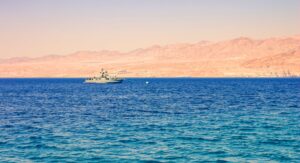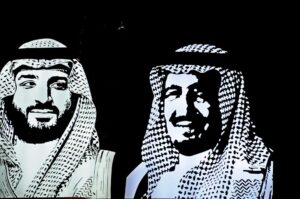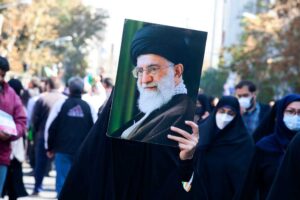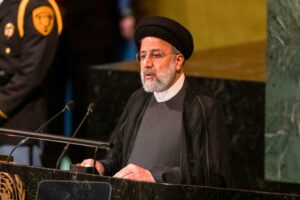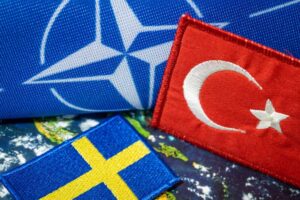This article is part of a multi-part series on Arab Gulf security.
Without periodic British or US interventions over the last 300 years, the contemporary map of the Arabian Gulf would undoubtedly be quite different. The survival of the Gulf Arab emirates has been a function of the confluence of dynastic and Great Power interests that held larger, more powerful regional rivals at bay. In this struggle to survive and prosper, the United Arab Emirates (UAE) – a federation of seven distinct emirates – each with its own dynasty, jealously guarded interests, and rivalries, is as unlikely a state structure as could be imagined in the Gulf. The role of Abu Dhabi and the Al Nahyan in the founding of the UAE is even more unlikely and yet inextricably linked. Quite simply, to understand the former, one must understand the latter. The idea of a functioning, overarching federal structure replacing the British Trucial arrangement was, to say the least improbable – the path to a federal state was even more so.
The existential focus on security and stability created and sustains the UAE.
Today’s ostentatious displays of disposable wealth – the Louvre and Guggenheim museum branches, the various marinas and malls, the world’s tallest building and largest Ferris wheel – obscure the existential focus on security and stability that created and sustains the UAE. From a policy perspective, what some Western experts have termed “the quest for indispensability” is an echo of the past adjusted to the contemporary geopolitical situation – an in-process “experiment within an experiment.” The first experiment is the federation of Trucial States into the UAE, and the second is the concerted effort on the part of the brothers, Sheikh Khalifa bin Zayed Al Nahyan, the emir, and Sheikh Mohammed bin Zayed Al Nahyan, to carry out a ‘forward’ policy intent on making the UAE an ‘indispensable partner’ in the region.
The Rise of Abu Dhabi in Context: Lessons Learned in the Trucial Era
The creation of the UAE and the role of Abu Dhabi and Sheikh Zayed are so inexorably linked that putting Abu Dhabi in its historical context is critical to understanding the last fifty years on the southern coast of the Gulf. The globalization of the 18th century and British imperial defense ‘East of Suez’ created the Gulf security system that supported the status quo among local rulers and the containment of threats to trade, such as piracy. For this reason, all the current dynasties in the Arab Gulf have ruled since the 18th century.[i] The British created an organized, systematized maritime security system that ended Al Qawasim and by proxy First Saudi State (1744–1818) dominance on the coast. From Ras al-Khaymah and Sharjah, Al Qawasimi naval power and depredations had enhanced Nejdi land-based raiding, expansion, and wealth.[ii] Eventually, the Saudi state and its Al Qawasim allies ran afoul of both the Ottoman and British Empires. In 1818, the Ottomans destroyed the First Saudi State, and in 1819, the British destroyed the naval power of Ras al-Khaymah and Sharjah. The rise of the Second Saudi Emirate (1824–1891) revived Al Qawasimi influence to some degree, but within a framework acutely mindful of British edicts.
In the mid-19th century, other emirates attempted to assert themselves mostly by abiding by the parameters of the British Trucial System. The desert Bani Yas appeared on Abu Dhabi Island in 1761 when the Al Nahyan discovered potable water. In the early 19th century, the Bani Yas joined with the Omanis in fighting the Saudis at Buraimi Oasis in the interior and benefited from the British 1820 General Treaty.[iii] Because they were a desert tribe, the British preferred the Bani Yas believing that they were less likely to cause maritime security issues. In the 1830s, feuding split the Bani Yas with the Al Bu Falasah tribe departing Abu Dhabi and permanently establishing the Al Maktoum on Dubai Creek.[iv] By the 1860s, suppression of the Al Qawasim expanded the ambitions of Abu Dhabi and brought a hard lesson in ‘overreach’. The Al Nahyan and Al Khalifa of Bahrain began a spectacularly unsuccessful war with the Al Thani and Qatar 1867–1868. The Al Thani were not only commercial rivals, but they also harbored tribal and familial rivals of the Bahraini ruler Mohammed bin Khalifa Al Khalifa (r. 1843–1868) as well as elements of the Al Naimi tribe, rivals of Abu Dhabi and Sheikh Zayed bin Khalifa Al Nahyan (Zayed the Great—r. 1855–1909). When it was over, the British had recognized the Al Thani as rulers of Qatar, severely sanctioned Abu Dhabi, and removed and exiled the Bahraini emir for ‘breaking the peace.
With war proscribed by the British, the Gulf emirates focused on trade. Initially, Sharjah controlled trade at the Iranian port of Bandar Lengeh. When the Qajar rulers of Iran revoked that right, the ruler of Dubai, Maktoum bin Hasher Al Maktoum, in 1901, declared Dubai a free port and invited traders from both Iran and the Arab Gulf to settle there. Dubai became the trading center and the most important of the Trucial States. Abu Dhabi was the impoverished distant Bani Yas cousin. Riven by family disputes and assassinations, Abu Dhabi was an impoverished backwater – that is until the search for oil arrived on the Trucial Coast. Certain of significant deposits on the Dhahira Plain, the British viewed Buraimi Oasis as the gateway and had two pathways for getting there – Oman and Abu Dhabi.[v] By 1945, the British concluded that Oman was not viable. Saudi Arabia’s increasingly aggressive claims, backed by the Arabian-American Oil Company (ARAMCO) research into historical tribal zakat arrangements, constituted a potential nightmare for the British.[vi] They found a proxy in Sheikh Zayed bin Sultan Al Nahyan, governor of the eastern province and the brother of Abu Dhabi’s ruler, Shakbut bin Sultan Al Nahyan (r. 1926–1966). Although religiously conservative, Zayed abhorred the fanaticism of the Wahhabi Saudis; however, the real animosity most likely stemmed from the Al Saud’s history of alliances with the Al Qawasim and from conflicting territorial claims in the desert including those around Buraimi Oasis.
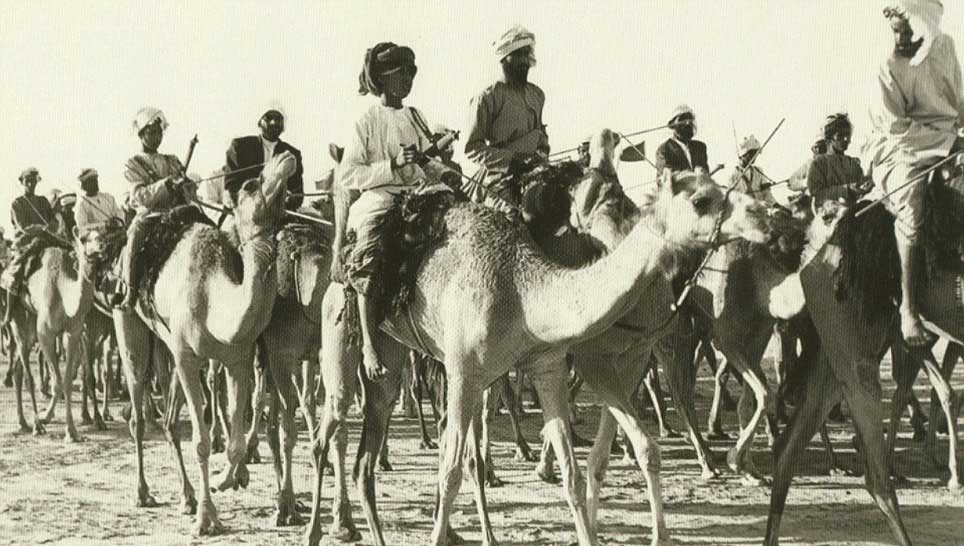

In the late 1940s, ARAMCO and Saudi Arabia created a detailed matrix of historical allegiances and zakat payments in the southern desert as a legal means of bolstering Saudi claims.[vii] In 1949, the British were alarmed to discover ARAMCO exploration parties with Saudi guards operating in the British oil concession granted by Abu Dhabi. Given the American involvement, the British opted for a go-slow approach rather than military force. In the fall of 1949, the Saudi government in Riyadh announced a claim to almost all of Abu Dhabi’s southern desert as well as parts of Oman and Qatar. Attempts to negotiate a settlement failed with the Saudis demanding the right to negotiate directly with the impoverished desert sheikhs – such an outcome would be a disaster for the British. In 1952, a Saudi expedition under Turki bin Abdullah al-Otaishan crossed the desert and set up shop at Hamasa. The choice of Turki bin Abdullah was no accident; he was the governor of Ras Tanura, the site of ARAMCO’s headquarters and had close relations with American business and government officials. In 1953, the legal department in the Foreign Office opposed submitting the Abu Dhabi suggested arbitration and opposed formal legal proceedings because the British “could not be certain of succeeding in a court of international law.”[viii] In 1955 after multiple failed conferences, the British ended the Saudi incursion by force. Sheikh Zayed’s modest deportment veiled a sophisticated calculating intelligence coupled with an impeccable understanding of Arab culture and etiquette. His unmatched and steadfast opposition to the Saudis solidified his reputation as a leader. In the aftermath of the Saudi’s ejection from Hamasa, the British “hoped” that King Saud bin Abd-al-Aziz Al Saud (r. 1953–1964) would be more cooperative. London dismissed US American concerns that King Saud, Ibn Saud’s son and successor, would target British interests as “all this emotional and somewhat egotistical poppycock” referring to Saudi Arabia as a “medieval and fundamentally rotten country.”[ix] They were mistaken. The Saudis broke relations with the British and carried on a campaign against Britain’s interests and allies, including Abu Dhabi, Aden, and Oman, for almost a decade.[x]
By the early 1960s, the British had concluded that Sheikh Shakbut was incapable of modernizing Abu Dhabi or more importantly protecting British petroleum interests. In 1966, Harold Wilson’s Labor government began to seriously contemplate a British withdrawal from the Gulf; therefore, because of oil, the situation in Abu Dhabi had to be stabilized and Shakbut had to go.[xi] In August 1966, the British and elements of the Al Nahyan staged a bloodless coup and Sheikh Zayed became the new ruler. In the north, the British withdrawal caused consternation. In Dubai, Sheikh Rashid bin Said Al Maktoum (r. 1958–1990) best expressed the attitude in the Arab Gulf: “Who asked them to leave? Abu Dhabi and Bahrain, and in the whole coast, people and rulers would all support the retaining of British forces in the Gulf, even if they may not give a direct answer out of respect for the general Arab view.”[xii] For the Trucial rulers, life without the British was a frightening prospect. Among the Trucial States, the British had regulated relations and settled disputes – including a brief shooting war between Abu Dhabi and Dubai in the late 1940s. The trade-based northern emirates feared and resented Abu Dhabi’s growing wealth and influence, but at the same time, participation in the new federation supported by oil rich Abu Dhabi gained them more or less the same level of Western protection. In the case of Abu Dhabi, Saudi Arabia immediately began to make noises about “border adjustments.” Then, all the emirates feared Iran and what appeared to be the carte blanche handed the Shah by the British and Americans.
Sheikh Zayed was the right person, at the right time, and in the right place for Abu Dhabi and the British – in a word, ‘indispensable’.
A freeze frame of the situation on the Trucial Coast leaves the viewer with a series of givens for the future. First and foremost, no matter what else might be said of Sheikh Zayed, he was the right person, at the right time, and in the right place for Abu Dhabi and the British – in a word, ‘indispensable’. Second, Abu Dhabi’s geological good fortune inverted roughly 300 years of the pecking order on the Trucial littoral. The metamorphosis has been a particular shock on the Al Maktoum and Dubai, whose reaction to Abu Dhabi’s rise as the preeminent power of the UAE has been less than gracious at times – given the centuries old rivalries, the new reality must be a hard pill to swallow. Zayed’s bequest also included a healthy skepticism about the motivations of his larger neighbors, particularly Tehran and Riyadh, and directly related to that, a sober understanding of geopolitical realities, namely that survival in a tough neighborhood requires powerful friends with shared interests. Then there is the last, somewhat more ephemeral, element – a desire to create something, to be taken seriously, a tribal sheikh’s sincere interest in the welfare of his people – these were the real drivers behind Zayed’s obsession with the Union.[xiii]
Zayed and the Union: The UAE 1971–2004
The British decision to withdraw was more of a psychological shock than a substantive one. Just the same, the end of a 150-year relationship caused apprehension. Now, London envisioned a mutually supportive ‘federation’ of emirates. The British idea of nine states – Bahrain, Qatar, Abu Dhabi, Dubai, Sharjah, Ajman, Um Al Quwain, Ras al-Khaymah and Fujairah – eventually proved unworkable. The addition of either Bahrain or Qatar, or both, simply brought too much historical and political baggage. Nevertheless, Sheikh Zayed in Abu Dhabi and Sheik Rashid bin Said Al Maktoum (r.1958–1990) in Dubai quickly announced the formation of a “federation between the two states, under one flag, which encompassed unified policies on foreign affairs, immigration, public services and defence, and internal policing.” At the February 1968, Dubai conference, it was apparent that including Bahrain and Qatar was problematic for everyone involved. A May 1969 meeting was a “disaster” as disagreement and rivalries came to the fore. The entire concept was in “desperate trouble.”[xiv]


In Britain, Edward Heath and the Conservative Party replaced Wilson’s Labour government and increased the pressure for federation – minus Bahrain and Qatar. On December 2, 1971, the UAE was announced: “In response to the desire of our Arab people, we, the rulers of Abu Dhabi, Dubai, Sharjah, Ajman, Umm Al Quwain, and Fujairah, have resolved to establish a federal state under the name of the United Arab Emirates.” Ras al-Khaymah refused to join in protest over the British role in the loss of the Tunbs islands to Iran. The northern emirates joined the union because it offered some protection from Iran and potentially from Arab nationalists and leftists, not because they intrinsically supported a union. Abu Dhabi’s oil guaranteed Western support against all comers including Saudi Arabia and Iran. Ras al-Khaymah joined in 1972 after Sheikh Zayed promised “full federal support” to peacefully regain the lost Gulf islands.[xv] The constitution expired in five years, the federal government was toothless, and, apart from Sheikh Zayed, no one really supported it.
In 1973–1974, because of the oil embargo and spiking prices, Abu Dhabi’s economic clout grew exponentially. Taking control of its petroleum resources including production and distribution and moving into new markets merely added to the bounty.[xvi] Reeling from shortages and price increases, the West faced the specter of a global recession.[xvii] The economic situation was good news for Sheikh Zayed’s plans as were the megalomaniacal pronouncements by the Shah of Iran and his new sobriquet, “the policeman of the Gulf,” replete with troops on the ground in Oman’s Dhofar province.[xviii] The leading rebel group, the Dhofar Liberation Front (DLF), had morphed into the Popular Front for the Liberation of Oman and the Arab Gulf (PFLOAG) backed by South Yemen, the Soviet Union, China, Egypt and others.[xix] Their manifesto called for the pursuit of “scientific socialism” through “organized revolutionary violence” in order to “escalate local tribal revolt(s) into an ideological movement with mass popular support throughout the Gulf.”[xx] Perhaps more frightening, the rebellion’s northern wing, the National Democratic Front for the Liberation of Oman and the Arabian Gulf (NDFLOAG), focused on Omani-UAE border regions and was in part composed of the Arab Soldiers of Oman who were British-trained former Trucial Omani Scouts (TOS), which was incorporated into the Union Defense Force (UDF).[xxi] The high number of Egyptians, Iraqis, Omanis, Adenis, Dhofaris, and others in the UDF increased the potential for an internal threat.[xxii] Unfortunately, a professional military force on the Trucial Coast has always required mercenaries.
In terms of leverage for Sheikh Zayed’s plans, the timing of the global recession of 1975–1976 could not have been better.[xxiii] For the most part opposed to centralization, the northern emirates were hard hit economically. Zayed demanded a new constitution with strengthened federal authority. The alternative was his resignation. There were acclamations of support and marches for solidarity that pressured the other rulers – no doubt organized with the knowledge of the federal government demanding an increase in federal power. Their populations having benefited from the union, the leaders of the northern five now faced a choice; they could continue to have support from Abu Dhabi through the union or Abu Dhabi could go its own way and they could fend for themselves.[xxiv]
Zayed coopted the ‘Emirati street’ with federal programs, that he had coopted the leadership of the emirates with financial support, and that Abu Dhabi had become to some degree the dynastic guarantor of old Trucial Coast.
By December 1976, Zayed had an agreement on paper with a new constitution calling for rapid integration of military, immigration, and internal security organs. In addition, a binding arbitration process was instituted to settle territorial claims between the emirates. Zayed also gained a paper commitment from the emirates to use their revenues for the funding of the federal government.[xxv] Zayed then announced his decision to remain as president of the union. Although the emirates failed to follow through on their commitments, Zayed had demonstrated that he had coopted the ‘Emirati street’ with federal programs, that he had coopted the leadership of the emirates with financial support, and that Abu Dhabi had become to some degree the dynastic guarantor of old Trucial Coast.
In 1978–1979, the Shah of Iran’s regime crumbled. Quickly, it became apparent that the Islamic Republic of Iran posed an exponentially greater threat. Ayatollah Khomeini called for an Islamic revolution against “kingship” in favor of rule by religious judges (fuqaha).[xxvi] In Abu Dhabi, Zayed, like the other rulers of the Gulf, understood exactly about whom Khomeini was talking. The amended constitution of 1976 gave the UAE federal government new authority, but the old dynastic rivalries largely prevented implementation. The only real supporter of a strong federal government was Zayed. Outside of that, the emirates continued to function largely independently. Now with the Iranian revolution, the situation had reached the point where something had to be done.
In February 1979, driven by events in Tehran, the Federal National Council (FNC) controlled by Sheikh Zayed issued a series of papers criticizing the Supreme Council of Rulers for their obstructionism, demanding a “permanent constitution” and consolidated federal authority. Dubai and others opposed the demands calling them “unconstitutional, rash, and ill-timed.” Zayed believed that centralization had become critical to survival. Traditional trade between the northern emirates and Iran now posed a security threat. The region was in chaos from Pakistan to Afghanistan to Mecca. The Gulf Arab states called for a new organization, the Gulf Cooperation Council (GCC). Some viewed it as the first step toward mutual security led by Saudi Arabia. For Zayed, who had opposed Saudi designs on Abu Dhabi for decades, putting the UAE in a position of subservience to Riyadh was a non-starter. At the same time, the UAE needed a strong role in the GCC.
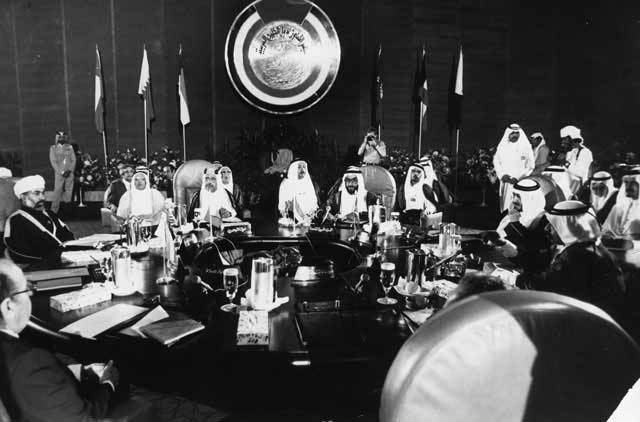
The inaugural GCC Summit in 1981 was hosted by Sheikh Zayed Bin Sultan Al Nahyan in Abu Dhabi (Gulf News Archive).
On the one hand, Sheikh Zayed argued for centralization of the UAE, but on the other hand, he needed to avoid compromising UAE sovereignty. Zayed recognized the best way to protect Abu Dhabi and the UAE’s interests was proactive participation in the GCC. To that end, the first GCC summit was held in Abu Dhabi demanding non-interference in the Gulf region, an end to the Iran-Iraq war, and a state for the Palestinians. At the same time, Zayed was contemplating the issue of Great Power backing for his rule and for the UAE itself.[xxvii] The GCC provided a regular forum in which Sheikh Zayed participated as the head of the UAE federal government ostensibly speaking for all the emirates. The reality was somewhat different. For example, during the Iran-Iraq war, the UAE remained officially neutral. Abu Dhabi and the GCC, however, provided support to Saddam Hussein while Dubai continued to trade with Iran and provided a transshipment point for war material. It was the old divide: Abu Dhabi had oil, and the northern states led by Dubai focused on trade with Iran as their primary partner. Its very large Iranian émigré population, lax security made Dubai and ongoing focus for security concerns both within the federal government and in the West. This concern was exacerbated by Iranian views and pronouncements that at a minimum the UAE littoral was an Iranian sphere of influence, if not actually Iranian territory.[xxviii]
Agreements with the French, British, and others were useful, but insufficient in and of themselves. The GCC would never be able to provide effective regional security.
During the next decade, the Iran-Iraq War, the Tanker War, and finally the Iraqi invasion and occupation of Kuwait made Sheikh Zayed an increasingly important ally for Western interests. No less important was the growing understanding in Abu Dhabi that the small Arab States of the Gulf were extremely vulnerable if they did not have the protection of a Great Power that was not only capable but willing to act to preserve the Gulf. The pronouncements at a given point in time on given topics were far less important than the reality that the only thing that actually stood between potential destruction of his hopes for the UAE and the prosperity of Arab littoral was a powerful ally. Agreements with the French, British, and others were useful, but insufficient in and of themselves. The GCC would never be able to provide effective regional security. In the end, only one country had the wherewithal to protect the Arab Gulf States – the United States. The Iraqi invasion of Kuwait drove home several points: first, wealth, diplomacy, and Arab brotherhood offered no protection; second, an emirate could vanish in less than a day; and last, just as it had been for 250 years, small, wealthy states needed a large powerful ally.
In 1980, Professor J.B. Kelly stated, “Zayid’s (sic) attention and energies are largely engaged by the politics of the UAE, and of the Gulf at large, and by the building up of his armed forces. …He aspires to a more prominent role on the Middle Eastern stage and even in the larger theater of international affairs.”[xxix] This assessment was absolutely correct and would carry through the end of his reign with only one addition. Zayed worked to make certain that there was an orderly transfer of power when he left the scene. Building on the ‘givens’ of the Trucial period, Zayed’s reign added new ones. First and foremost, succession could not be left to chance – Zayed selected his successors and the order of succession and then did everything that he could to make sure that it happened as he planned. He succeeded.[xxx] Second, he made the federal government a reality in the everyday lives of the Arab street in all the emirates – he succeeded to some degree in separating citizens from their local rulers. Welfare state or not, Emirati citizens increasingly looked to the federal government for solutions to their problems. Of course, that has risks as well because credit and blame are two sides of the same coin. Zayed also used Abu Dhabi’s wealth to coopt to one degree or another the leaders of the other emirates.
Abu Dhabi supported Iraq with a fundamentally anti-Iranian policy, and Dubai supported Iran by providing transshipment of war materials and the technology for the early nuclear weapons program. This same division carried over into the 1990s with terrorism and Al Qaeda.
Here again, it is something of a symbiotic relationship. In 1971 and 1976, Zayed leveraged support from the other rulers for his union efforts despite their deep-seated aversion to centralization of power; however, they gave up few of their prerogatives. A fact demonstrated by the trifurcation of policy during the Iran-Iraq War, the UAE is neutral to maintain “unity.” Abu Dhabi supported Iraq with a fundamentally anti-Iranian policy, and Dubai supported Iran by providing transshipment of war materials and the technology for the early nuclear weapons program. This same division carried over into the 1990s with terrorism and Al Qaeda with Dubai getting prominent mention in the 9/11 report for its laissez faire business practices. Financial leverage only worked to a point, and the downside of economic collapse in the northern emirates would threaten the entire coast. The UAE government was left with the task of defending Dubai when in fact Abu Dhabi, the real supporter of the federal government, opposed Dubai’s policies on any number of security and strategic issues.
Finally, the combination of experiences from the formation of the UAE through the invasion of Kuwait and beyond left a series of unanswered questions about the broader issue of allies and security guarantees. The security situation was remarkably like that of the Trucial arrangement only with the UAE federal government in place of the Raj attempting to establish the parameters. Certain vague redlines were established, but the exact consequences of violating those redlines were not clear or were plain nonexistent. Of course, federal policy had to take into consideration the fundamental difference between Abu Dhabi’s situation and that of the trading commercial interests of the northern emirates to say nothing of managing the Al Nahyan-Al Maktoum rivalry. There was certainly no upside for the federal government to take over the day-to-day management of the individual emirates were that even possible, but at the same time, the permissive or non-existent security policies in the north could not be allowed to threaten the overall security of the Arab coast. The UAE and more specifically Abu Dhabi needed a ‘special’ relationship with the West, and with the United States in particular, that would ensure survival and support prosperity. From a US point of view, there were questions about the value of a relationship with the UAE federal government as opposed to Abu Dhabi. The federal government had no real control of the component emirates. On important issues, the UAE federal government might maintain neutrality, while the other emirates took positions diametrically opposed to those of the union and each other. This was particularly problematic regarding Iran. Because of a lack of centralized control, the UAE was unable to protect itself, Abu Dhabi, or its Western allies against policies of member emirates that were injurious to everyone. The UAE house had to be put in order if Abu Dhabi wanted to be taken seriously as a security and defense partner – a solution had to be found to this quandary of control. By 2004, this issue of UAE federal control had become the key to the goal of ‘indispensability.’ The process of achieving it was a separate question – was it even possible?
[i] Willem Floor, The Persian Gulf: The Rise of the Arabs – the Politics of Trade on the Persian Littoral 1747–1792 (Washington, D.C.: Mage Publishers, 2007): fn 9/Pedro Teixeira, The Travels – 25. Prior to that, security was more contested. From the late 15th century through mid-18th centuries, the Hormuzi states and Oman figured prominently in struggles for control of the Gulf. Allied with various partners – the Portuguese, the Persians, and the Ottomans, the chroniclers of the Gulf state that the Hormuzi states were unmatched in naval and maritime capability even in medieval times and they feared no one on the mainland. Without a doubt, their neutralization in the 18th century changed the power dynamic in the Gulf. See also Willem Floor, The Persian Gulf: A Political and Economic History of Five Port Cities, 1500–1730 (Mage Publishers, 2006): 7—133. The Hormuz section provides an interesting perspective on the island and its development.
[ii] Charles Belgrave, The Pirate Coast (New York: Roy Publishers Inc., 1966): 33–37. From a British point of view, the Al Qawasim were simply pirates. Ideologically, they followed the Hanbali school of Islam of which the Wahhabi reform movement was a part. The longest surviving dynasties on the southern coast, the Al Qawasim bridled at the term ‘pirate’ viewing themselves as ‘legitimate’ privateers. See also Sultan Bin Muhammad Al-Qasimi, Machtkämpfe und Handel in der Gölfregion 1620–1820 (Zürich: Olms Georg AG, 2017). The author is the ruler of Sharjah and a historian. He has written this work to partially to debunk the ‘Pirate Coast’ label, but it is a reasonably good narrative of the Al Qawasim and their role in the struggles for trade and empire.
[iii] Clarence Mann, Abu Dhabi: Birth of an Oil Sheikhdom (Beirut: Khayats, 1964): 23–28.
[iv] J. B. Kelly, Britain and the Persian Gulf, 1795–1880 (Oxford: Clarendon Press, 1968): 354–360. The British analysis was essentially correct. Over the coming decades, the weakness of Abu Dhabi in the face of Al Qawasim resurgence and British commitment to the emirate’s survival was a source of innumerable complicated problems. In 1834, Abu Dhabi forced a rethinking of British policy. In fact, the British ties with Abu Dhabi demanded a rethinking of the overall maritime peace as it related to British neutrality in disputes among the Trucial sheikhs. Problems in 1834 to 1835 provide an example. Uncharacteristic, Sheikh Khalifa bin Shakbut Al Nahyan (r. 1833–1845) launched pirating operations in the Gulf. Seventeen ships were lost, and their crews slaughtered. The British immediately launched reprisals and forced the Bani Yas to pay indemnities and fines, but at the same time, the British realized that Sheikh Khalifa had acted out of desperation because of the threat from the Al Qawasim to his pearling operations and trade. In 1835, the British intervened and negotiated a temporary truce between the Al Qawasim and the Al Nahyan. Roby C Barrett, The Gulf and the Struggle for Hegemony: Arabs, Iranians, and the West in Conflict (Washington, D.C.: The Middle East Institute, 2016): 241.
[v] Michael Quentin Morton, Buraimi, The Struggle for Power, Influence, and Oil in Arabia (London: I.B. Tauris, 2013): 44, 55. Morton’s book, particularly the chapters “Lanterns in the Dark” and “A tale of Two Brothers,” details the activities of British oil companies, the role of the famous explorer Wilfred Thesiger, the failure of Sultan Said of Oman to exploit his claims as well as the internecine, murderous competition for control within the Bani Yas.
[vi] One of the Five Pillars of Islam, Zakat or alms giving is often looked at as a narrow act of giving to the poor. Zakat also has much broader political implications as well which indicate patronage or client status. It was often used to delineate boundaries between emirates or states claiming a given area of land. This tactic by Saudi Arabia had real potential to legitimized Saudi claims in Abu Dhabi’s eastern desert and more importantly the British oil concession.
[vii] Morton, Buraimi, 74. Zakat “was the cornerstone of Saudi territorial claims in southeastern Arabia: it could be used to prove sovereignty over vast stretches of barren desert” covering equally vast deposits of oil.
[viii] “Brief on Saudi Arabian Frontier Dispute for the United Kingdom Delegation to the United Nations 18 April 1953,” FO371/104294, EA1081/518. When the Saudis demanded a plebiscite in the region, the British refused because it would “confirm a situation which the Saudis had falsely and improperly created.” In other words, al-Otaishan and the Saudis would have won the election. The British claims on behalf of Abu Dhabi and Oman and the rest of the Gulf for that matter were based on the “Blue” and “Violet” lines established by the unratified Anglo-Ottoman agreements of 1913–1914. They were just lines on a map and the Foreign Office legal department actually advised against using the Ottoman agreement as a basis for claims, but the British government had little else. Ibn Saud argued that there “never had been a border, and that the tribes in the Hadramawt, Buraimi, Dhofar, Oman, and Qatar had a zakat arrangement with Riyadh and furnished the Saudis with tribal levies. Interestingly, Sir Percy Cox, the British Resident in the Gulf, had warned in 1926: “Practically he (Ibn Saud) thinks that he is justified in principle, in regaining any territory that his forefathers had a century ago, whether as territory or as a ‘sphere of influence.’ Oman was in their sphere o influence … I have little doubt but that in the course of time he will seek to extend his authority over the interior of Oman.” This also included Buraimi and the interior of Abu Dhabi. In the 1950s, Saudi Arabia used Cox’s report to justify their claims.
[ix] “Report on Buraimi from R.W. Parkes, Jidda, to C.A.E. Shuckburgh, FO, Eastern Department,” December 15, 1955 (FO371-114633).
[x] J.B. Kelly, Eastern Arabian Frontiers (London: Faber and Faber, 1964): 260–280. Eden had a particularly bad habit of misjudging costs whether in his dealings with Nazi Germany in the 1930s or with Nasser at Suez.
[xi] Davis McKie and Chris Cook, The Decade of Disillusion: British Politics in the Sixties (London: St. Martin’s Press, Ltd., 1972): 53, 95. Because of Vietnam, the US and in particular President Lyndon Johnson, saw the British withdrawals (particularly from Southeast Asia) as a stab in the back. He viewed security in the Gulf as the British contribution to global Western security and now Prime Minister Harold Wilson, “the little creep camping on my doorstep” as Johnson called him, had dumped everything, including the Gulf, in the US’s lap. See Simon C. Smith, Britain’s Revival and Fall in the Gulf: Kuwait, Bahrain, Qatar, and the Trucial States, 1950–1971 (New York: Routledge Press, 2004): 78–108. The British would make the same decision in Oman and assist in removing Sultan Said bin Taymur Al Said (r. 1932–1970) in favor of his son Sultan Qaboos bin Said (r. 1970–2020). Sultan Said, like Sheikh Shakbut, had progressively fallen out of favor in London due to his inability to deal with successive crises. See Barrett, The Gulf, 320–321.
[xii] Kelly, Arabia, the Gulf, and the West, 80.
[xiii] Andrea B Rugh, The Political Culture of Leadership in the United Arab Emirates (London: Palgrave – MacMillan, 2007): 93–94. Rugh portrays Zayed as a master at the art of persuasion and hospitality with an undercurrent of subtle manipulation.
[xiv] Graeme H. Wilson, Saqr: Fifty Years and More (London: Media Prima, 2007): 217–226.” While any “authorized” biography in the Gulf raises questions about objectivity, Wilson’s work – minus the ‘adulation’- is actually a solid record of the process of federation formulation and the existence of frictions between the emirates, if not a frank explanation of the roots of those frictions. The nine-state UAE was unworkable from almost the very beginning. Bahrain had no intention of joining a federation unless representation was based on population. Bahrain’s population was greater than the other emirates combined and, therefore, they would be politically in the driver’s seat. No one would agree to that. In the case of Qatar, Doha wanted a ‘tiered’ union in which the richer emirates, Qatar, Bahrain, Abu Dhabi, and Dubai, formed one group, and the five northern emirates were placed in another lesser group. Then, there were the rivalries. Qatar had a longstanding existential rivalry with Bahrain and Abu Dhabi. The 1867 war was not forgotten or forgiven. In addition, Qatar had good relations with Dubai who had for years been Abu Dhabi’s primary rival on the coast. In the final analysis, both Bahrain and Qatar decided to go it alone, and Sheikh Zayed must have secretly breathed a sigh of relief. The seven-emirate configuration was complicated enough with clearly territorial disputes among the emirates and de facto presence of two blocks – Dubai and Abu Dhabi in the south, and the five poorer emirates in the north.
[xv] Wilson, Saqr, 236–255. In return for the Shah’s renunciation of Iranian claims to Bahrain and large purchase of British military equipment by Tehran, the British informed Ras al-Khaymah and Sharjah that they would no longer support their claims to the Gulf islands of Abu Musa and the Greater and Lesser Tunbs. In effect, they were told to come to an agreement with Tehran or face Iranian occupation of the islands. By 1970–1971, the British made it clear that they wanted the federation done. The issue of Iran and the three islands provided another means to pressure Ras al-Khaymah and the northern states.
[xvi] Funding Universe: The Abu Dhabi National Oil Company History, http://www.fundinguniverse.com/ company-histories/abu-dhabi-national-oil-company-history/
[xvii] Michael Corbett, Oil Shock of 1973–1974 – Federal Reserve History (St. Louis: Economic Research the Federal Reserve Bank of St. Louis): https://www.federalreservehistory.org/essays/oil-shock-of-1973-74 Arthur Burns, the chairman of the US Federal Reserve stated, the “manipulation of oil prices and supplies by the oil-exporting countries came at a most inopportune time” adding to inflationary pressures and eventually led to a full-blown global recession.
[xviii] An Iranian-born scholar and commentator on Iranian affairs quoted in Barrett, The Gulf, 381.
[xix] Peter Thwaites, Muscat Command (London: Leo Cooper, 1995): 74.
[xx] Ahmed Hamud al-Maamiry, Oman and East Africa (New Delhi: Lancers Books, 1979): 116–117.
[xxi] Maamiry, Oman and East Africa, 117–118.
[xxii] Kelly, Arabia, the Gulf, and the West, 206–207.
[xxiii] The confluence of these threats likely goes a long way in explaining why British Petroleum was allowed to keep an ownership position in the Abu Dhabi National Oil Company (ADNOC) and other petroleum interests when foreign companies were largely removed from ownership positions in other Gulf oil operations. In addition to internal conflicts and rivalries between the emirates, Zayed and the sheikhs of the other six emirates had to contend with the potential threats of the Kingdom, Iran, and the Soviet supported leftists with the possibility that threats could find roots in remnants of the old Trucial military establishment. Because of Vietnam, the US was still reluctant to engage in new military commitments on the ground anywhere, Zayed had to at least consider the possibility that the UAE might be next state requesting active British assistance in the form of the SAS; therefore, it would be much better if the British were incentivized to provide it. See also Barrett, The Gulf, 89–91. Ironically, the Shah’s ego trip contributed significantly to his undoing, and it would be the Gulf Arabs and their newfound economic clout that gave the initial hard shove that pushed him over the precipice. As the economic crisis of 1976 worsened, US President Gerald Ford asked the Shah to provide some relief on oil prices. Enraged, the Shah declared, “Iran would not ‘commit suicide’ because the West could not put its house in order. He bragged in Al Ahram, the most important newspaper in the Arab world, “Now we are the master, and our former masters are our slaves. Every day, they beat a track to our door begging for favours and offering weapons and nuclear power stations in return.” Riyadh saw its chance to deflate the Shah and replace Iran as the most reliable US ally in the region. The Shah needed another oil price increase at the December 1976 OPEC Conference in Doha to support the spending in his defense and domestic programs. The Saudis in collusion with the US torpedoed the increase and wrecked the Shah’s budget and development programs. Within 24 months, the Pahlavi regime was swept away in a revolution, the consequences of which the Arab Gulf and the West are still attempting to manage. Andrew Scott Cooper, “Showdown at Doha: The Secret Oil Deal that Helped Sink the Shah,” Middle East Journal (Autumn 2008): 581–587.
[xxiv] Richard F. Nyrop, et al. Area Handbook for the Persian Gulf States (Washington, D.C.: US Government Printing Office, 1977): 281–284.
[xxv] Nyrop, Handbook, 283. See also J.B. Kelly, Arabia, the Gulf, and the West, 204–205. Kelly argues that the other six emirates paid almost nothing because they viewed the federal government as an attempt by Abu Dhabi and Sheikh Zayed to centralize power over the entire coast. In discussing the 1970s, Kelly argued, “Shaikh Rashid (of Dubai) is contemptuous of Abu Dhabi’s pretensions as the leader of the federation” and that Sheikh Saqr of Ras al-Khaymah supported the federation only because he had “little option but to continue to look to Zayid as his financial patron.” No matter what their private views, the leaders of the Gulf emirates all benefited from Abu Dhabi’s wealth and wanted those benefits to continue. No doubt their growing dependence on Abu Dhabi’s wealth nurtured resentments.
[xxvi] Ervand Abrahamian, Khomeinism: Essays on the Islamic Republic (Berkeley: University of California Press, 1993): 21. Khomeini’s governing principles were spelled out in Velayat-e Fiqh: Hakumat-e Islami (The Jurist’s Guardianship: Islamic Government) in which he argued, among other things, that kingship was pagan and had no place in an Islamic society.
[xxvii] “Timeline of the GCC Summit,” Gulf News (December 5, 2010): https://gulfnews.com/world/gulf/timeline -of-the-gcc-summit-1.723199
[xxviii] Karim Sadjadpour, “The Battle of Dubai: The United Arab Emirates and the U.S.-Iran Cold War,” The Carnegie Papers (July 11, 2011): 5–6: https://carnegieendowment.org/files/dubai_iran.pdf
[xxix] Kelly, Arabia, the Gulf, and the West, 207–208.
[xxx] Rugh, Political Culture, 89–94.







